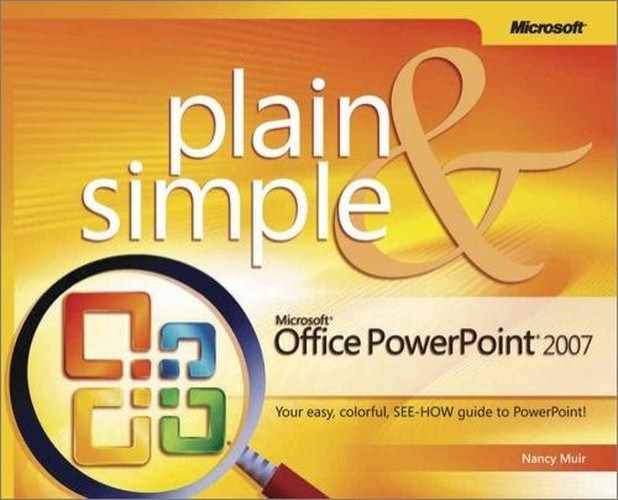The ability to publish a presentation to the Internet as a Web document allows you to share your ideas with anybody, any time. You could, for example, publish your presentation as a follow up to giving it in person, so your audience can review or print out the content for themselves, at their leisure. You might also publish a presentation to the Web for others to review and suggest changes before you present it.
You can save a presentation in a couple of Web page formats. Web Page saves all the files of your presentation in a single folder for publishing on the Web. Single File Web Page saves your file in a multi-lingual hypertext markup language (MHTML) format that provides your Web page contents in a single file, which is somewhat smaller than the folder version and can be easier to manage if you email your site contents to others.
Finally, you can modify various Web options that allow you to include navigation tools, resize graphics for browser windows, and apply settings for fonts and other elements of the presentation to optimize it for the Web. For example, you can specify whether navigation controls should be included so that those viewing the page can easily move from slide to slide, which browsers are most likely to be used to view the presentation, and how fonts are managed when your slides are viewed online.
When you save a presentation as a Web Page, you save an .htm file along with various files required for your Web page, such as the graphic images, sounds, styles, and so on. If you want to edit your Web site with some other program such as FrontPage, the Web Page format is your best bet. If you choose to save as a Single File Web Page, you save a single file that includes all the elements of your presentation; this presentation is easier to share but not editable.
Tip
If you have access to a SharePoint site online, you might also explore publishing your presentation in a document workspace in the PowerPoint Help system. This allows easy sharing with others who have access to your site.
Tip
Previous versions of PowerPoint contained a Web toolbar, but that feature is gone in 2007. Instead, you can add Web tools to the Quick Access toolbar (see Chapter 2 for more about this toolbar). The tools you can place here include the Web Options button and Web Page Preview button.
Tip
You can add a word or words that help identify the file by clicking in the Add A Tag field in the Save As dialog box. These act as keywords you can use to locate the file. If you add a tag to a file and then click the Office button, Prepare, and finally Properties, you will see any tags you added listed as keywords on the Summary tab.
 Click the various tabs to change the following settings:
Click the various tabs to change the following settings:General tab. Here you indicate that you want to include navigation controls, to show animations when somebody is browsing your presentation, or to resize graphics to fit the viewer’s browser window.
Browsers tab. Here you can select the browser most people are likely to use to view your presentation, and various options for dealing with graphics and Web page formats.
Files tab. Here you set can control how Web files are organized and which is the default editor for Web pages you create in Office.
Pictures tab. Set the screen resolution for your presentation here.
Encoding tab. You can choose different character sets, such as Western European, ASCII, or Japanese to save presentations in.
Fonts tab. Choose the default fonts for your presentation here.
 Click Save to save the Web file with the settings you’ve made.
Click Save to save the Web file with the settings you’ve made.
See Also
For information about saving your presentation to the default PowerPoint format, see "Save a Presentation".
Tip
This task saves a file or set of files to your hard drive or storage media in a Web page format; to publish the presentation to the Web see the next task, "Publishing a Presentation as a Web Page."





